Serviços Personalizados
Artigo
Indicadores
Links relacionados
-
 Citado por Google
Citado por Google -
 Similares em Google
Similares em Google
Compartilhar
Journal of the Southern African Institute of Mining and Metallurgy
versão On-line ISSN 2411-9717
versão impressa ISSN 2225-6253
J. S. Afr. Inst. Min. Metall. vol.113 no.4 Johannesburg Abr. 2013
PAPERS
Determination of the coefficients of restitution, static and rolling friction of Eskom-grade coal for discrete element modelling
V.B. Teffo; N. Naudé
Department of Materials Science and Metallurgical Engineering, University of Pretoria
SYNOPSIS
The aim of the project was to experimentally determine the coefficient of restitution, and static and rolling friction of Eskom-grade coal for discrete element modelling (DEM). These parameters will be used in further DEM studies to simulate the flow and behaviour of coal during conveyance. For the simulation to yield realistic results, the parameters for the different coal shapes identified in the samples were determined. DEM uses spherical particles, and it was found that the difference between the DEM default parameters and those measured is significantly different, by as much as 97%, which illustrates the importance of experimentally determining these parameters. The spherical particles in DEM can be used to construct the various coal shapes identified, and the parameters measured can be used to simulate realistic results. The conveyance system can then be optimized accordingly.
Keywords: coal, coefficient of restitution, coefficient of static friction, coefficient of rolling friction, DEM.
Introduction
Many of Eskom's coal-fired power stations are built right next to the coal mine - this means that the coal is supplied by conveyor belts (Eskom, 2012). For Eskom to be efficient at generating electricity, the conveyor system needs to be reliable and efficient in conveying the coal, and unscheduled downtime is to be avoided.
Unscheduled downtime is typically caused by transfer plugging, belt and chute damage, and material spillage. The root cause of such problems is normally in the design, installation, maintenance, and operation of the system. However, it is usually easier to correct a design problem before construction, as opposed to after construction. Hence, the use of mathematical models to test systems for optimization and to eliminate problems with the design - this is done by simulating the materials flow behaviour (Alspaugh, 2005). One such technique is discrete element modelling (DEM).
The aim of the project was to experimentally determine the coefficients of restitution, and static and rolling friction of Eskom-grade coal for DEM. These are input parameters to the numerical model DEM for the simulation of the flow behaviour of granular material. The parameters will be used in the modelling of coal behaviour through feed chutes.
The coal samples that were used were from Anglo American Coal's Navigation coal mine (blend of seam 1 and 2) and Exxaro's Inyanda coal mine (seam 1). Both mines are situated in Mpumalanga Province, just outside the Witbank area.
Literature review Coal
Coal is composed of a number of distinct entities - that is, macerals, which are organic substances, and minerals, which are inorganic. The organic components consist of a complex mixture of carbon components (C-H-O-N-S), and the inorganic component makes up the ash content, that is, SiO2, Al2O3, etc . Each of the coal macerals and minerals has a unique set of physical and chemical properties, which controls the overall behaviour of coal (Habashi, 1997).
Conveying coal
Belt conveyors play a critical role in the transportation of coal. They are used extensively during mining, processing, storage, transportation, and finally, in the generation of energy (Alspaugh, 2005). Figure 1 depicts a typical conveyor system used in the transportation of coal.

Conveyors typically deliver small amounts of material over long periods of time, and as such, it is essential that they operate efficiently with minimum downtime and deliver a steady stream of material continually. Some of the problems that create unscheduled downtime are transfer plugging, belt and chute damage, and spillage. The root causes of these problems are normally in the design, installation, maintenance, and operation of the system. It is usually easier to correct design issues before construction as opposed to after construction, and hence various mathematical models are used extensively to test systems for optimization, to identify and eliminate problems with a design before it is commissioned, and have assurance that the equipment will perform as required under different conditions of flow behaviour (Alspaugh, 2005).
Discrete element model (EDEM software package)
In order to represent the actual flow of a material in EDEM (Experts in Discrete Element Modelling), various parameters need to be measured experimentally. These parameters include the coefficient of static friction, coefficient of rolling friction, and the coefficient of restitution.
Coefficient of restitution
Coefficient of restitution can be defined as the ratio of the differences in velocities before and after the collision, that is:

where v2 and vi are the relative velocities of the colliding bodies after impact, and v1 and v2 the relative velocities of the colliding bodies before impact (Mangwandia et al., 2007).
A perfectly elastic collision has a coefficient of restitution of 1, while a perfectly inelastic collision has a coefficient of restitution of 0, thus the coefficient of restitution is between zero and 1 for any particle/collision. The value depends on the material type, particle geometry, and the relative velocities of the particles at impact.
The coefficient of restitution is an important parameter in DEM simulations since it is incorporated in the DEM contact models. To calculate it for individual particles, as required by DEM, the potential energies before and after collision are related:

where hr is the rebound height and hi is the impact height Coefficient of static friction
The coefficient of static friction (µs) is defined as the ratio of the static friction force (fs) to the normal force of an element (Fn) on a surface:.

It is used to calculate the amount of force required to impart motion to an object that is initially at rest on another object, and it is largely dependent on the material interaction and the surface finish at the point of contact. It is an important parameter in DEM and needs to be accurately specified as it greatly affects particle flow behaviour.
Coefficient of rolling friction
Coefficient of rolling friction is used to determine the amount of torque required to impart motion to an object that is initially at rest on a flat surface. Empirically it is defined by:

Experimental procedure
Sampling and sample preparation
The coal sample (ROM) from Inyanda coal mine was wet when it was received. The coal was first dried in the laboratory oven to remove all the surface or free moisture, then screened using a vibrating screen into five size fractions.
The +10.2 mm - 22 mm and + 22 mm - 50 mm size fractions were used for the experimental work. These two size fractions were selected because Eskom typically receives the coal from the mine in that size range.
The two size fractions were first split into manageable masses using a riffle splitter. They were then each split to obtain a homogeneous and representative sample before they were blended together to give a total sample mass of approximately 25 kg, which is the recommended sample size for the selected size range.
From the representative sample, two different particle shapes were identified, and particles selected according to those shapes were then used for experimentation. The two different shapes that were identified are shown in Figures 2 and 3.


The same procedure was followed in preparing the sample from Navigation. Three different particle shapes were identified in the Navigation coal, and are shown in Figures 4, 5, and 6.



Coefficient of static friction
The slope test set-up as shown in Figure 7, and a measuring tape, were used.

The test for measuring the coefficient of static friction is based on classical mechanics, and Figure 7 shows how it is defined.
From the theoretical definition of the coefficient of static friction and classical mechanics, the coefficient of static friction is defined as follows:

To measure the coefficient for the coal-on-steel impact, the set-up as depicted in Figure 8 was used. The coal sample was placed on the steel plate., which was then adjusted until the coal particle was just about to move. The plate was locked in using the lever, and finally, the height and length of the plate were measured using the measuring tape. The height and length were then used to calculate the coefficient according to the definition in Equation [5].

For the coal-on-coal impact, the angle of repose was measured. When one pours bulk material on a horizontal surface, the material forms a conical pile,and the angle between the horizontal and the surface of the pile when the material is on the verge of sliding is known as the angle of the repose.
To measure the angle of repose, the bulk coal was poured onto a horizontal surface as depicted in Figure 9. The diameter and height of the pile were measured, and Equation [6] was used to calculate the angle and subsequently the coefficient.

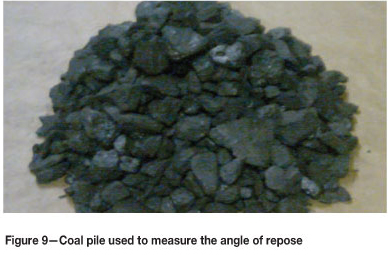
where d is the radius of the pile and h the height.
Coefficient of rolling friction
A slope test set-up as shown in Figure 10, a high-speed camera, Tippex, arts and crafts glue, and a measuring tape were used.
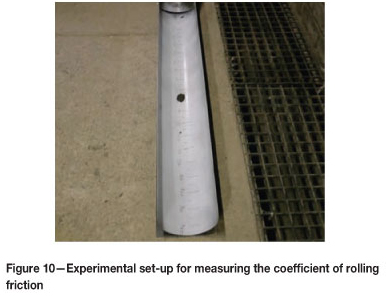
The coefficient of rolling friction is defined as follows according to classical mechanics (see also Figure 11):
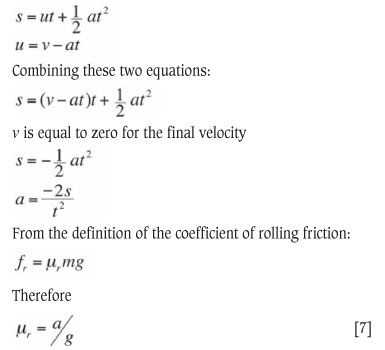
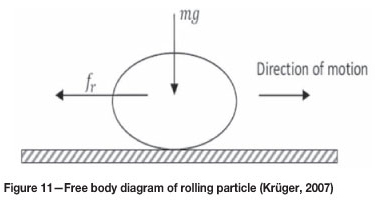
To measure the coefficient of rolling friction for the coal-on-steel impact, the set-up in Figure 10 was used. The set-up consisted of two pipes that were joined together, one sloping pipe and one large pipe. The sloping pipe was used to accelerate the particle. The particle was placed on the sloping pipe and allowed to move down until it collided with the large pipe at the impact point (where the two pipes were joined). A high-speed camera was used to capture the motion of the particle; the motion was then played in HD Writer AE 3.0 and analysed by calculating the number of frames it took the particle to move from the impact point until it stopped and dividing that by the frame rate of the camera (50 frames per second). This then gave the time that the particle travelled until it stopped. The distance that the particle travelled was measured using the measuring tape. The data was then used to calculate the coefficient as defined in Equation 7.
For the coal-on-coal impact, coal was milled and glued onto the surface of the set-up with the arts and crafts glue, as shown in Figure 12. The test coal particles were marked with Tippex so that they were visible when the camera captured the motion. The same procedure for determining the coefficient for the coal-on-steel impact was then followed.
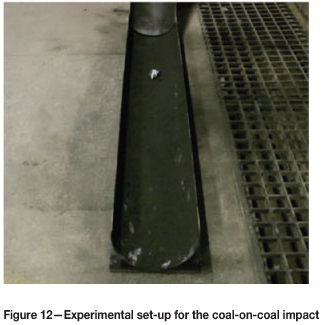
Coefficient of restitution
The pendulum set-up shown in Figure 13, a string, a highspeed camera, and epoxy glue were used.
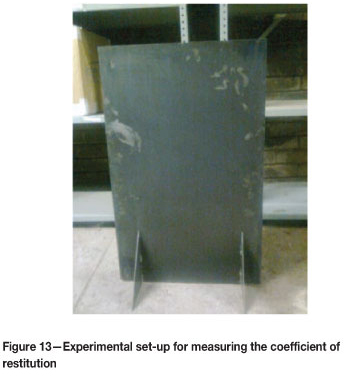
The pendulum test (based on classical mechanics) was performed by attaching each coal particle to a lightweight string. The string was extended and the coal particle was dropped from a specific height and allowed to impact the steel plate (coal-on-steel impact). This is shown in Figure 14. A high -speed camera was used to capture the motion of the particle. The video was then played in HD Writer AE 3.0, and a snapshot of the particle after impact with the steel was captured, and that was analysed in the Engauge program to measure the rebound and impact height (Figure 14). The rebound and impact height were used to calculate the coefficient of restitution as defined in Equation [2].
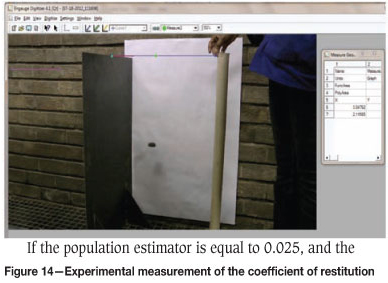
To measure the coefficient of restitution for the coal-on-coal impact, a chunk of coal was cut using a diamond cutter to create a smooth, surface; the coal was glued onto the steel plate as shown in Figure 15 using epoxy glue. The same procedure for determining the coefficient for coal-on-steel impact was followed.
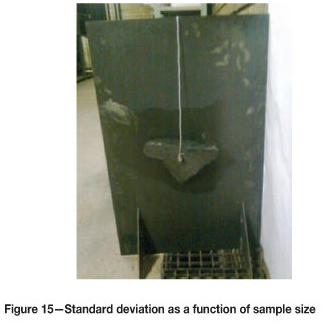
Statistics
Single particles were used to do the test work, and as such it was important to know how many times each test was to be repeated for the measured value to be as close as possible to the true value. In statistics, Equation 8 is used to calculate how many times an experiment should be repeated for normal distribution.

where n is the sample size, Za/2 is the z-score (which is equal to 1.96 for a 95% confidence level), and σ is the population estimator (population standard deviation).
The population estimator was not known for the samples that were used, and to estimate it, a simple method was devised. The test was repeated a number of times, and each time the standard deviation was calculated. A graph of sample size as a function of standard deviation was then drawn (Figure 16). From the graph, it was seen that as the test was repeated a number of times, the standard deviation approached a certain value, which was then used as the population estimator.
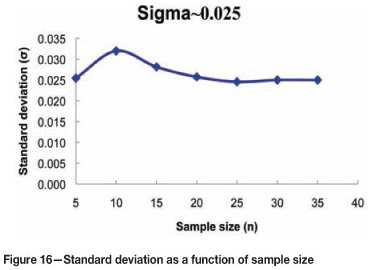
To be sure that the measured value was close to the true value, a 95% confidence level was chosen. This was used to calculate the margin of error (E). The margin of error is defined as half the confidence interval length. For a 95% confidence level, the confidence interval length is defined by Equation [9].

margin of error is 0.01 and the z-score is 1.96, then the test should be repeated 24 times - that is, the sample size is 24. This exercise was done for each experimental test (the tests were repeated about 400 times in total).
Results and discussions
The results for all the experimental tests are shown in Table I.
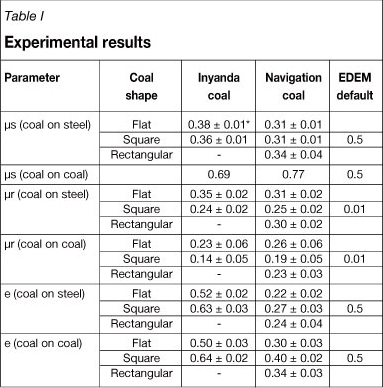
It can be seen from Table I that the difference between the measured parameters and those in the EDEM programme is significant, being as high as 97% for some parameters. The difference in the parameters can have a significant impact on the design of the material handling system, that is, the angle of the chute design, the slope angle of the conveyor belt, etc. This can subsequently affect the efficiency of the material handling system, and the quality of the product, that is material degradation.
This clearly shows the importance of experimentally determining the coefficients so that the simulation yields results that are realistic, as opposed to simulation using the default values that are based on spherical particles only.
Since EDEM uses spherical particles for modelling, the identified shapes in the coal sample can be constructed using the spherical shapes as shown in Figure 17, and the measured parameters can be used as input data. The simulation can then be done with confidence that realistic results will be obtained.
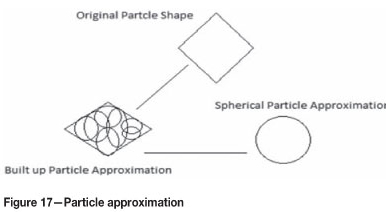
Conclusions
The default parameters in EDEM are based on spherical particles. However, in reality there are various shapes of coal particles present. EDEM spherical particles can be used to approximate the actual coal particle shapes, and the measured parameters for the different shapes can then be used as input parameters to the program so that the simulation yields realistic results on coal handleability. This will allow for the designing of a material handling system that can work optimally with reduced unscheduled downtime, loss of production, delays in delivery of product, and maintenance cost, and it will also save on the cost of redesigning and replacing the system.
Acknowledgements
The author would like to thank Anglo American Thermal Coal's Navigation coal processing plant and Exxaro's Inyanda coal mine for providing the coal samples, the University of Pretoria for all the support, and Dr Naudé for her supervision.
References
Alspaugh, M.A. 2005. Coal conveyance-system design vs. reliability. Presentation to PRB Coal User's Group, IL, Chicago, 5-7 April 2005. [ Links ]
Boltz, H.A. and Hagemann, G.E. 1958. Materials Handling Handbook. Ronald Press Wiley. New York. [ Links ]
Brummer, J. 2010. Discrete element modelling with varying moisture content for sand. Student project, Department of Mechanical and Aeronautical Engineering, University of Pretoria, South Africa. [ Links ]
Eskom. 2012. Company information. http://www.eskom.co.za/c740/company-information/ [Accessed 25 July 2012] [ Links ].
Grima, A.P. and Wypych, P.W. 2011a. Discrete element simulations of granular pile formation: Method for calibrating discrete element models. Engineering Computations, vol. 28, no. 3. pp.314-339. [ Links ]
Grima, A.P. and Wypych, P.W. 2011b. Development and validation of calibration methods for discrete element modelling. Granular Matter, vol. 13. pp. 127-132. [ Links ]
Grima, A., Hastie, D., Wypych, P., and LaRouche, R. 2011. The beginning of a new era in design: calibrated discrete element modelling. Australian Bulk Handling Review, September/october. pp. 14-21 [ Links ]
Habashi, F. (ed.). 1997. Handbook of Extractive Metallurgy. Wiley-VCH. [ Links ]
Halliday, D., Resnic, R., and Walker, J. 2005. Fundamentals of physics. 7th edn. John Wiley & Sons. [ Links ]
Krüger, A.L. 2007. Discrete element modelling validation and verification for coal. Student project, Department of Mechanical and Aeronautical Engineering, University of Pretoria, South Africa. [ Links ]
Mangwandia, C., Cheonga, Y., Adamsb, M., Hounslowa, M., and Samana, A. 2007. The coefficient of restitution of different representative types of granules. Chemical Engineering Science. pp. 437-450. [ Links ]
Paper received Dec. 2012
Revised paper received Dec. 2012.
© The Southern African Institute of Mining and Metallurgy, 2013. ISSN2225-6253
Paper written on project work carried out in partial fulfilment of B. Eng (Metallurgy)














